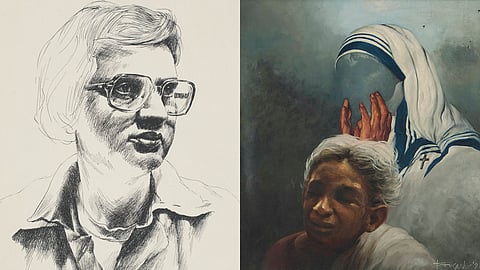- HOMEGROWN WORLD
- #HGCREATORS
- #HGEXPLORE
- #HGVOICES
- #HGSHOP
- CAREERS
- ABOUT US
- CONTACT US

In the early 1970s, painter Bikash Bhattacharjee took the Indian art scene by storm with his paintings of dolls. The 1970s saw the revolutionary Naxalite movement surge in Bengal, and Bhattacharjee's paintings of dolls rummaging through ordinary Bengali households, hanging from clotheslines on the roofs of old Kolkata family homes, and lying on the streets conjured up an eerie sense of unease and dissonance. Through this series of paintings, Bhattacharjee used the seemingly harmless motif of a doll — literally a child's plaything — as a metaphor for the commonplace violence, terror, and dread that haunted Kolkatans at the time. The ingenuity of the series found critical acclaim and catapulted Bhattacharjee to the upper echelons of the modern Indian art scene.
An Ordinary Beginning Of An Extraordinary Career
Bikash Bhattacharjee was born to a middle-class Bengali family on 21 June, 1940, and lost his father when he was only six years old. His childhood, marked by material and psychological struggles, influenced him deeply and equipped him with a profound sense of empathy for the underprivileged. As a student of the Indian College of Arts and Draughtsmanship in the late 1950s, he'd often spend as much as twelve hours a day painting and sketching the Bengali middle class, their daily lives, aspirations as well as the crumbling buildings and rooftops of North Kolkata, where he grew up. His early works from the 1950s were primarily plein-air watercolour studies of Kolkata's architecture and street life.
For The Love Of The Feminine Form
Even as a student, and throughout his career, Bhattacharjee was fascinated by the female figure and painted women in a variety of forms — as ordinary women going about their daily lives, affluent women in their refined but superficial social bubbles, and sex workers with their practical wisdom and indignations. Bhattacharjee's women occupied the liminal space between domesticity and desire.
As an artist, Bhattacharjee loved women and their bodies — but his love for the feminine form came from a deep appreciation of the female body and its anatomy. His gaze wasn't guided only by women's sexuality and desirability, but by an empathetic exploration of the ways women were repressed, sexualised, domesticated and desired in 20th-century Kolkata, and the ways women subverted such societal expectations. Most of Bhattacharjee's models and inspirations were Bengali middle-class women he came across in the course of his life, and sex workers from Kolkata's red light areas.
A Surrealist Bent
Unlike his contemporary modernists who more or less abandoned academic realism, Bhattacharjee used it to disturb viewers into confronting what lies beneath the surface of reality. From the 1960s onward, human figures became the primary focus of Bhattacharjee's practice, and he painted people with a near photographic realism.
Beginning in the 1970s, however, Bhattacharjee's work took a decidedly surrealist bent. He experimented with the human anatomy, introducing animal morphology and juxtaposing youth with old age, drawing people as eyeless dolls, and infusing ordinary figures with layers of allegory, metaphor, and symbolism. Bhattacharjee was greatly influenced by the works of Western artists like Andrew Wyeth, Francis Bacon, Salvador Dali and René Magritte, as well as Indian and Bangladeshi artists like Chittaprosad, Somnath Hore, and Zainul Abedin whose social realist bodies of work depicted the socio-political upheavals — like war, famine, unrest, and revolutionary movements — which rocked the subcontinent at the time.
Bikash Bhattacharjee's realist style, tinged with surrealist undertones, captured the tones and textures of middle-class Bengali life with a sensitivity that was both tender and unsettling. From eyeless dolls symbolising the trauma of the Naxalite years to haunting portraits of ordinary women caught between domesticity and desire, Bhattacharjee's work offers a complex visual archive of 20th-century Kolkata.
Bhattacharjee was awarded the Lalit Kala Akademi's prestigious national award in 1971. In 1987, he was honoured with the Bangla Ratna by the Government of West Bengal, followed by the Padma Shri, one of India's highest civilian awards, in 1988. He passed away on December 18, 2006, leaving behind a legacy that continues to shape Indian art.
If you enjoyed reading this, here's more from Homegrown:
How Bengali Modernist Painter Gobardhan Ash Challenged Traditional Artistic Expression
A Poet, Playwright, Painter & Physician: The Legacy Of Mumbai's Very Own Gieve Patel
Celebrating The Legacy Of Meera Mukherjee: A Sculptor, Painter, Diarist, & Activist
